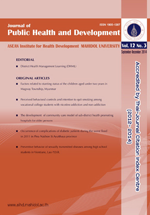Development of the indicators of administration potentiality for local health security funds in National Health Security Office Region 10, Ubon Ratchathani, Thailand
Main Article Content
Abstract
The objectives of this study was to establish and develop indicators and to assess and validate the indicators for measurement the capacity and potential of the local administration controlling the Local Health Security Fund (LHSF). The research took form of mixed methods which combined qualitative and quantitative research methods.
This study was started by studying related concepts and theories and synthesizing them into components and then into indicators. Concepts on administration potentiality were studied from related textbooks, academic documents and research reports published domestically and abroad. As a next step the possible components and indicators were explored in focus group discussions, in – depth interviews and finally in an operational seminar attended by community health alliance members, other stakeholders and experts. A Delphi technique of consensus development was used comprising three rounds. The subjects comprised 1,540 LHSFs administrative staff selected using proportional stratified random sampling of the population of staff in Health Region 10 . The main quantitative data collection tool was a five – level Likert scale questionnaire with a reliability of .980 and validity ranging from 0.71 to 1.00.
The results of this study given guidelines document and wide support for developing an assessment instrument for measuring the capacity of local administration overseeing the LHSFs and the assessment instrument developed comprised 9 components and 65 indicators; (1) Leadership component is composed of 5 indicators, (2) Strategic Planning component is composed of 6 indicators, (3) Process Management component is composed of 11 indicators, (4) Customer and Stakeholder Participation component is composed of 7 indicators, (5) Measuring, Analysis and Knowledge Management component is composed of 10 indicators, (6) Human Resource Development component is composed of 3 indicators, (7) Output component is composed of 11 indicators, (8) Outcome component is composed of 9 indicators and (9) Health Status Impact component is composed of 3 indicators. The assessment instrument developed was congruent with empirical data, χ2 = 1.520, df = 13, p - value = 0.101, GFI = 0.997, AGFI = 0.990 and RMSEA = 0.018
The suggested that it was feasible to implement the assessment instrument in local government organizations and that comparative data on LHSFs capacity and potential would help policy makers identify where they need to invest to improve administrative capacity.


